Photos: Kip Miller
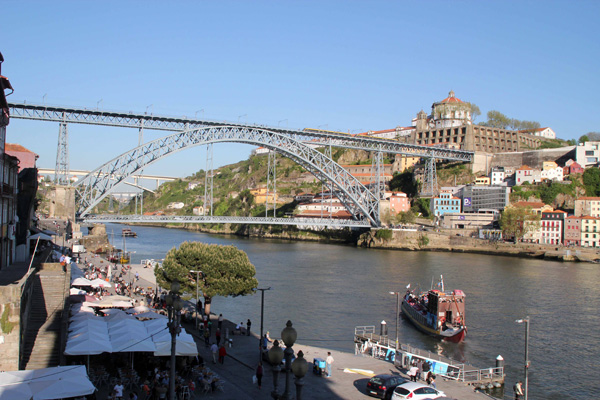
The double-decker Ponte Luis Bridge, built by Theophile Syrig, a colleague
of Gustave Eiffel, connects to Vila Nova de Gaia and its celebrated wine lodges
My husband and I are among the lucky ones headed to Porto. Our bus approaches the city on a sky-blue afternoon, tracing the mighty Douro below us through the city's jumbled streets. "Porto was named by the Romans," comments our knowledgeable tour director Jesús, coordinator of our sojourn in Portugal. Just beyond Henry the Navigator Square we come to an abrupt stop. "This is as far as the bus can go," he announces. "Follow me downhill to our hotel at the river's edge. It's the most happening place in Porto." We gingerly wheel our hand luggage toward Pestana Porto, an upscale hostelry that encompasses two vintage warehouses that have been stylishly interconnected. Commanding a prime view of the riverfront and the Dom Luis Bridge, the hotel also includes a notable restaurant headed by chef Rui Martins. "Have a look. We are right in the middle of the action!" exclaims my husband as he opens the shutters in our room. Below on Pra?a da Ribeira, a square ranked as a UNESCO World Heritage Site, people are chatting animatedly in crowded cafes, the river and bridge practically at our fingertips.
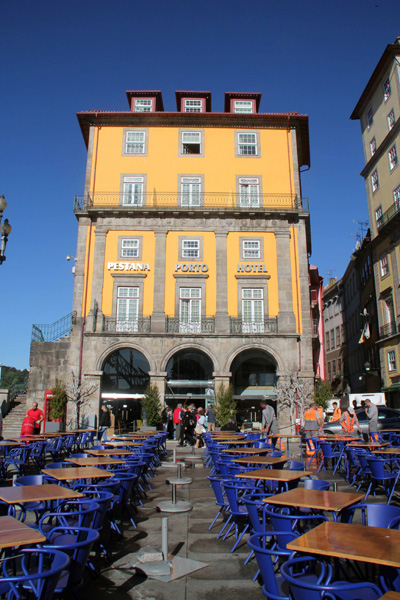
On the riverfront, the upscale Pestana Porto Hotel overlooks Praca da Ribeira,
the medieval core of the city and a UNESCO world heritage site.
A moonlight stroll on the lively quay is magical. Strains of soulful fado drift out of a music bar, soon overtaken by a jazz combo from another. I get a whiff of grilled shrimp redolent with garlic as we pass by Casinha Sao Jao, a cozy, cave-like restaurant showcasing assorted tapas. Nearby, Azeitonera do Porto, is offering tastes of local wines accompanied by herbed olives and tiny sardines. "It's a shame we've already eaten," sigh Eric and Kathy, our touring companions and decades-long friends, as we continue to the twinkling iron bridge. Built by a partner of Gustave Eiffel, the iconic Ponte Dom Luis was completed in 1886, at that time the longest iron arch in the world. A metro train whooshes overhead on the upper level. On the lower level, a steady row of cars and pedestrians is making its way across. Beyond the bridge, the mystical cloisters of the Serra do Pilar Monastery glitter against the night sky.
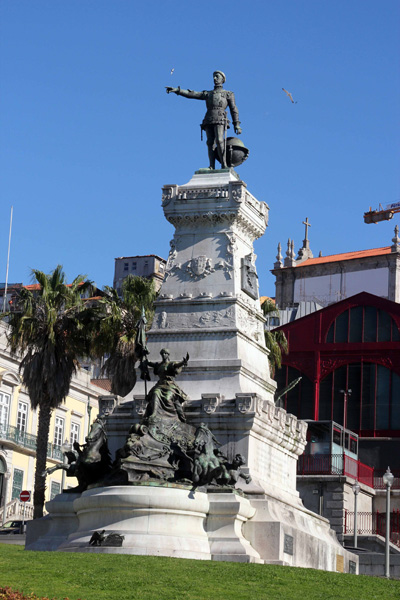
Henry the Navigator Square is dominated by a huge statue of its namesake. Henry launched
Portugal's Age of Discovery by sending shiploads of intrepid explorers to Africa.
Porto reveals its charms slowly, requiring time to wander and discover.
Ribeira's cobbled medieval quarter is a huddle of narrow streets filled
with colorful tall houses strung with laundry flapping in the breeze.
Grandmothers call out to each other from second floor balconies above
tiny emporiums selling bacalao (dried cod). The aroma of broa, toothsome
corn bread, wafts out of wood-burning ovens. But our time in Porto is
short, so we begin our morning with a stroll past the birthplace of Henry
the Navigator, to be followed by a bus ride through the entire breadth
of the city. "Henry's name is synonymous with Porto and all of Portugal,"
explains Jorge, our good-humored local guide. He points to a carved sign
above the doorway--"Talent de Bien Faire"--the desire to do
well. It's an aptly-chosen phrase, because Henry, the son of King Joao
I, was immensely accomplished: scholar, knight, monk, and most of all,
great adventurer, one who initiated the Age of Discovery and gold trade,
adding new territories and riches to Portugal through his expeditions
to coastal Africa. Our bus circles Henry the Navigator Square, where a
grand sculpture of its namesake was installed in 1884. To the west, the
neoclassic Palacio da Bolsa, Porto's former stock exchange building, is
renowned for its breathtaking decor. "The gilded Arabian room is
a must see," says Jorge. "It was inspired by the Alhambra. Today
the room is used as a concert hall, drawing visitors from all over the
world."
Soaring above the city is Clérigos Tower, the tallest structure in Porto. It was built by Nasoni, a Tuscan architect who left his imprint everywhere. "If you find the time, wind up its 225 thigh-burning steps to get a panoramic view," recommends Jorge with a devilish smile. A swing on the broad Avenida dos Aliados, a boulevard that was added to Liberdade Square in 1916, reveals an impressive lineup of Belle Époque buildings. Here are many of the city's major banks, luxury hotels, and plenty of cafes. At one end, the City Hall is a standout, distinguished by a bell tower with carillon clock. "Aliados is a great gathering place," Jorge boasts as we drive past a huge sculpture of King Pedro IV on his horse, "especially on holidays when everyone comes here to see and be seen. Even the Queen of England and the Pope have attended festivities here."
Nearby, on Rua do Campo, two famous Baroque churches nearly touch each other. The Igreja do Carmo is adorned with blue azulejos depicting the founding of the Carmelite order in the Holy Land. A one-meter house, undoubtedly the narrowest in the world, separates it from the Igreja dos Carmelitas, a convent for disabled nuns, acting as a guarantor of chastity between the two institutions. "But no one lives in the house today," says Jorge. "It's a sign of our liberated times." We swing past Livraria Lello, home to one of Europe's most beautiful bookstores. Lello's is housed in an Art Nouveau building and is renowned for its large collection of English language titles. Here came J.K. Rowling, the popular author who taught English in Porto for two years, drawing inspiration from its pointed arches, swirling staircase and stained glass ceiling for Hogwart's Castle in her "Harry Potter" series. "Photos are only permitted during a one-hour period each morning, but try to see it anyway," Jorge urges.
I marvel at Porto's newer sections, growing more affluent with each kilometer. In the Boa Vista District, two contemporary buildings have greatly enriched cultural life in the city. Casa da Música, a performance hall designed by Dutch architect Rem Koolhaas, opened its doors in 2008, receiving international acclaim for its ground-breaking design. "When Casa was inaugurated, I heard people swear that a large meteorite had landed in the city," comments Jorge. "Casa resembles a shoe box on steroids, but it has exceptional acoustics," he chuckles as we circle around the building. Three kilometers to the west, in an enormous landscaped park complete with ornamental lakes and footpaths, we pass Serralves, the Museum of Contemporary Art. Completed in 1999, it is the brainchild of minimalist architect Álvaro Siza Vieira, a Pritzker Prize laureate who also designed its furniture and fittings. The Serralves brings in cutting-edge traveling exhibitions, often collaborating with the Whitney Museum of American Art and other institutions. Today it ranks as the country's most visited museum. "Every year at the end of May, a free public festival takes place here for a 40-hour, non-stop period," says Jorge. "There are all kinds of performances and crafts exhibitions. Over 100,000 people attend."
We approach
Foz do Douro where the river meets the ocean, the most exclusive neighborhood
in Porto Here, opulent villas compete with new apartment buildings with
unusual geometric shapes. The seafront is lined with cafes, bars and a
romantic promenade known as Pergola da Foz. "This is the best spot
to relax and just enjoy the view," crows Jorge. "After your
third glass of port, you will swear that you can see the Statue of Liberty!"
A little to the south, the tall lighthouse of Felgueiras rises on a long
breakwater at the Douro's mouth. We gape at the churning ocean from afar.
Giant waves crash against boulders and sea spray shoots high up into the
air. Nearby, the squat tower of Sao Miguel-o-Anjo, dating from 1757, is
the oldest lighthouse in Portugal. "It was built using the same techniques
as the Alexandria Lighthouse," notes Jorge. "From this very
spot Henry the Navigator sent off his ships on their voyages of discovery."
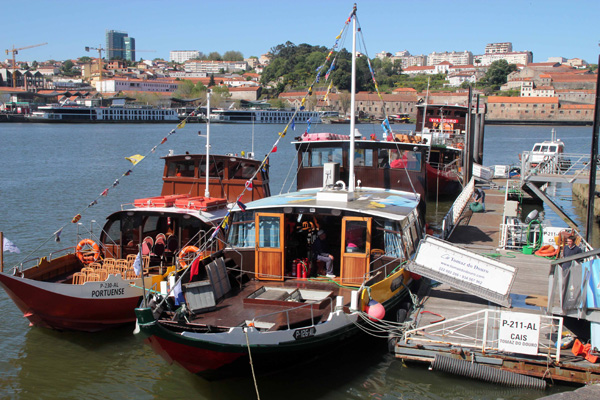
Motorized rabelo-styled boats ply the Douro River, transporting tourists to
Vila Nova de Gaia where acclaimed lodges offer tasting tours of port wine.
Returning to Porto alongside the north bank of the river, I glance at Arrábida, the most westerly of six bridges that span the Douro. Today's river is torpid, a far cry from its notorious heyday when turbulent rapids and treacherous shallows, not to mention narrow gorges, brought many workers transporting wine barrels on flat-keeled cargo boats known as rabelos to their untimely deaths. "Winemaking was a dangerous business during the port industry's early centuries," Jorge admits. "Even bringing the rabelos back up to the Valley was difficult. Sometimes they had to be pulled against the rushing river by teams of oxen on shore." After centuries of fighting the river, a series of five dams was built from 1964-1985 on a 210-mile stretch of the Douro. Today, navigational locks control the flow of water in the river and also enable cruise boats to bring tourists to its wine estates. "The Douro is the world's oldest demarcated wine region," boasts Jorge, "and it has its most unique climate: nine months of infierno and three months of invierno."
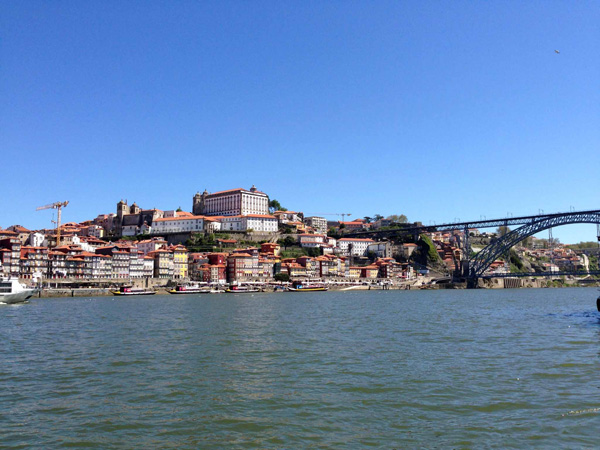
Porto's impressive Bishop's Palace crowns a knoll next to its main Cathedral, the Sé. In centuries past, bishops
exerted enormous power over the city and their palace is testimony to numerous costly renovations.
In front of the yellow facade of our hotel, a tour boat awaits to take us on a "six bridges" cruise. Viewed from the Douro, Porto's panorama of skinny houses and terra cotta roofs is a showstopper. Cathedral spires rise against an azure sky and chunks of crenelated city walls emerge here and there. Dominating the scene on its own knoll is the massive Bishop's Palace, with the Sé, Porto's main cathedral, just behind it. The palace has been rebuilt several times, based on Baroque renovations drawn by Nasoni. "Its size reflects the immense power that the Church held over Porto in centuries past," Jorge explains. Our boat heads toward Arrábida and then reverses course, moving upstream under the Ponte Luis and continuing past the iron Maria Pia built by Gustave Eiffel himself in 1877. We reach the last and newest of Porto's six bridges, the Infante D. Henrique, completed in 2003. It holds the world record for the longest concrete arch.
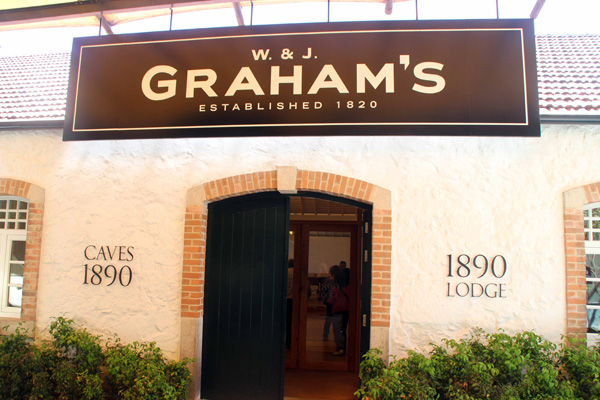
Graham's, a family-owned English company operating 28 quintas on the terraced
banks of the Douro, is considered the port industry's premier company
"Now it's time to discover the magic of port," announces Jorge.
According to Jesús we are in for a treat, because Jorge is quite
the oenologist, having previously worked at Sandeman, one of the Douro
Valley's elite winemakers. We disembark at the Vila Nova de Gaia and board
a bus headed to Graham's Lodge, nominated in 2016 as the world's most
admired port brand. My own experience with port is almost non-existent.
I vaguely remember sampling it years earlier in Oxford, accompanied by
a chunk of Stilton and a nibble of chocolate. "I'm ready to learn,"
I tell Eric, whose wine palate is quite refined. Graham's history dates
back to 1820, when it became one of the first English companies to invest
in vineyards in the Douro Valley. Today it operates some 28 quintas (wine
estates) in the Alto Douro that are owned and managed by five brothers
and several cousins of the Symington family. We peruse an elaborate display
on Graham's history, complete with a recent thank you letter from the
Queen for a special port commemorating her 90th birthday. Another letter
from Churchill extols the virtues of Graham's, his favorite brand. Antique
cooper's tools and a display of vintage port bottles adorn a back wall.
Downstairs,
Graham's temperature-controlled cellars are lined with endless rows of
hand-made, French oak casks and vats. This is where crushed grapes from
the Valley come to rest. "Barefoot treading is still part of the
tradition in many estates," notes Jorge. "The pits remain in
the juice to ward against bitterness. Sugar is released, turning to alcohol.
Table wine has about 13% alcohol, but port is sweeter and stronger. To
stop fermentation, a neutral grape spirit is added. The result is the
more potent port, with 20% alcohol." This procedure dates back to
the early years of port production when it was discovered that adding
a wine spirit prevented deterioration during shipping.
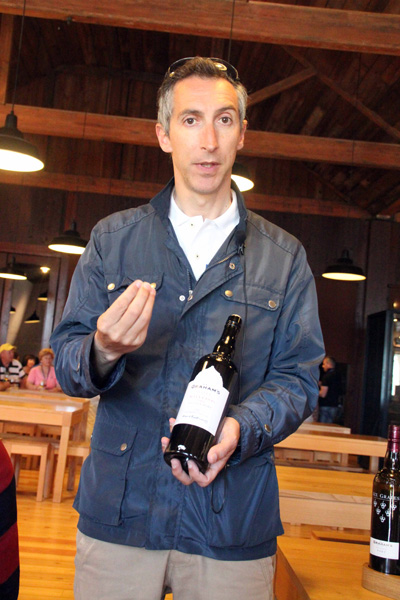
An accomplished oenologist, Jorge, a tour guide extraordinaire, relates
the nuances of port winemaking with grace and good humor.
"I am going to explain the differences between the three main varieties
of port," Jorge announces. This is all new to me, of course. I sneak
a satisfied smile at my husband. "Ruby port ages in a big vat for
about three years," Jorge begins. "In a cask, rubies can age
a little longer. The big vat allows a ruby to keep its characteristics
and the tannins are not very pronounced. Ruby is great to serve with chocolate,
cheese and fruit." I learn that tawny ports rest in a big vats for
two years, then are transferred to smaller casks to allow for faster oxidation.
"Some of the casks here are nearly 100 years old," notes Jorge.
"There is more sediment in casks and the wine gets lighter in color.
Tawny port can rest in these casks for up to 30 years or more. Food pairing
will depend on its age."
To gain their extra qualities, vintage ports must age in a bottle. "This process can last decades, or even more," Jorge explains. Candidates for the vintage category are sampled by the Douro Port Wine Institute's board of tasters who evaluate them. Those that meet prescribed standards are authorized to be labeled as "vintage." Generally, vintage port is decanted before serving. "The oldest vintage bottle at Graham's dates from 1868," Jorge divulges, pausing in front a dark corner stacked with rarefied bottles. Under the right cellaring conditions, vintage port can be kept for 100 years or more. Rarity of a vintage will dictates its price. Since most Vila Nova de Gaia cellars were built from the late 18th century to the first decade of the 19th, many have a good stash of vintage. "Here at Graham's we employ the two-thirds rule. We will only sell a third of any vintage year, and keep the rest," Jorge comments as he leads us to a tasting room.
We gather
around tables set with three glasses per place. A dark ruby reserve, about
5 or 6 years old, is poured. It is fruity and easy to drink, with only
a hint of tannin. Remembering Oxford, I long for some cheese and chocolate
to accompany it! A ten-year-old tawny has amber edges and is more complex,
with caramel and dry fruit overtones. "Tawny port is best served
slightly chilled as an aperitif," says Jorge, "or as a dessert
wine with almonds and pears, or even a crème brulée. Older
tawny ports develop a cognac-like quality, with a longer finish. They
are best served as a digestif." We sample a #23 vintage port that
has spent about ten years in a bottle. It is complex and rich. "Vintage
is paired with cheese and chocolate, just the same as ruby port,"'
Jorge explains. We step outside to a trellised terrace to take in a sweeping
view of Porto and the river. On our left, Vinum, Graham's premier restaurant,
is doing a brisk lunch business. The menu looks tempting, but we opt to
return to the city for further exploration.
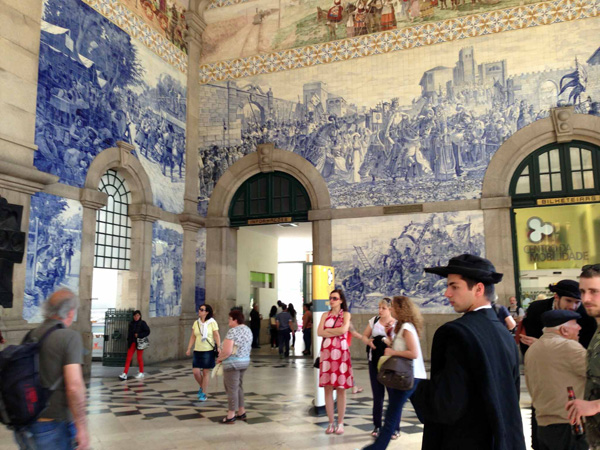
Sao Bento, Porto's world-renowned train station, is adorned with 20,000 tin-glazed
azulejos depicting important moments in the country's history.
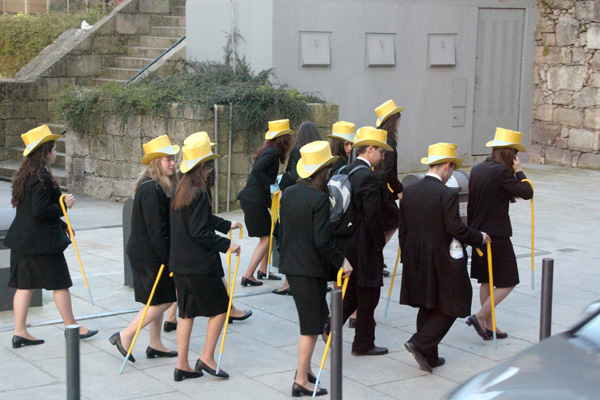
Early in May, graduating students take to the streets in black capes, hats and canes during Porto's annual "
Queima das Fitas," a lively, week-long celebration marking the end of the academic year.
Only on foot does one fully appreciate the steepness of Porto's streets.
"I bet a record number of steps will be show up on your Fit Bit by
evening," I tell my husband as we strain uphill toward Sao Bento,
considered one of the most beautiful train stations in the world. Named
after a Benedictine monastery that once occupied the site, it is distinguished
by a large vestibule covered with 20,000 tin-glazed azulejos, mostly in
blue and white, depicting important historical moments in Portugal's past.
Dating from 1905-1916, the tiles are the work of Jorge Colaco, considered
the best azulejo painter of his time. We squeeze into a group of tourists
and students perusing the Battle of Valdevez in 1140, the arrival of King
John in 1387, and Henry the Navigator's Conquest of Ceuta in North Africa,
among other scenes. Above the main panels, a multi-color border portraying
the history of transportation frames an elaborate Beaux-Arts ceiling.
Can there be another site in Portugal that better embodies its artistic
legacy?
We head out,
blending into a sea of people. During the first week of May thousands
of students take to the streets, some dressed in flowing black capes and
carrying long canes. It's their annual "Queima das Fitas," a
boisterous, week-long celebration that takes place in Porto and Coimbra.
Dating from the 19th century, Queima is made up of 12 events that commemorate
the end of the school year, including a "burning of the ribbons,"
a symbolic farewell to academic life for graduating students. It begins
with a Sunday serenáta (songfest featuring fado music) near the
Porto Cathedral and reaches its peak on Tuesday with cortéjo académico,
a grand procession leading to Avenida dos Aliados and the City Hall where
students are greeted by the Mayor. There are concerts in the park where
small tents are erected serving wine and beer. It's a rowdy, joyous affair.
And today is Tuesday! We make our way through the crowds, noting that
many students seem to be play-acting: Graduates are identified by top
hats and briefcases, their canes aloft, with colorful ribbons that denote
their academic specialty, while freshmen participate in little vignettes
wearing comical baby and animal costumes. Everywhere, tiled facades are
festooned with banners and flowers. "Please, please take our picture,"
several groups of freshmen plead as we push through the raucous horde.
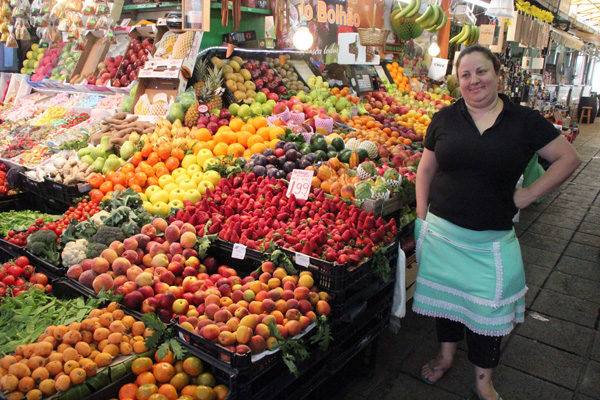
A jovial greengrocer stands ready to help in front of mounds of luscious fruit at Belhao, Porto's premier food market.
Not far from the celebrants on Rua da Bandera is Mercado Bolhao, Chef
Jamie Oliver's favorite European market, built over the site of a small
creek. It's a huge, two-story structure jam-packed with rowdy fishmongers,
butchers, bakers, greengrocers and florists. Interspersed among the fresh
fare are souvenir stalls and even a few restaurants. Here, the definitive
word is "pregao," meaning "please, how can I help you?"
I pass by a flamboyant fishmonger lady hawking her last cache of Atlantic
cod. Nearby, Turista is a casual eatery famed for Porto's popular monster
sandwich, the francesinha. This meat lover's delight, also known as "croque-monsieur
gone wild," is beloved by locals. It includes cured ham, sweet and
spicy linguica sausage, and tender steak all covered with melted cheese,
plus a side of fries! We step outside to Confeitaria do Bolhao, surely
one of the most beautiful Art Deco shops in the world, accented with chartreuse
tiles and mirrors. Display cases tempt with arrays of pastries, croissants
and glazed cookies. The scent of freshly brewed coffee permeates the air.
I suddenly remember Jorge bragging that "coffee in Porto is by far
the best in the world, especially when served with pastéis de náta,
Portugal's tiny custards." How we resisted taking his suggestion
is beyond me!
It's been a long and wonderful day and fatigue is setting in. We begin a slow descent toward the Pestana, noting that Porto deserves a protracted stay. I make a mental list of all the landmarks we have yet to see, the Douro Valley Cruise we'd love to take, the tastes still to be savored, the multitude of shops to be explored. "And wouldn't it be lovely to learn a little Portuguese before we return," I mumble to myself.
